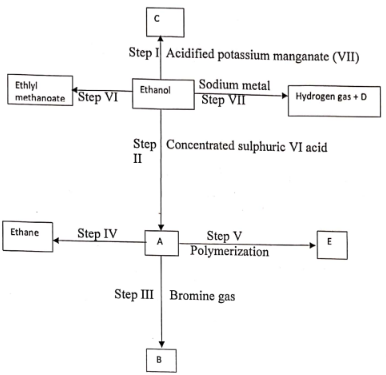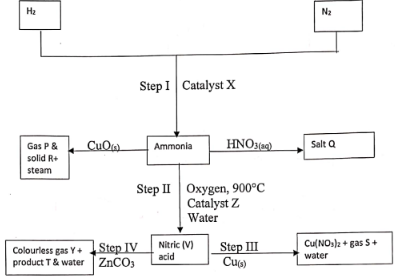101 INSTRUCTIONS TO CANDIDATES
- Answer all questions
- Mathematical tables and silent electronic calculators may be used for calculations
- All workings must be clearly shown where necessary.
- The table below shows data on the elements K to R. Study it and answer questions that follow. The letters used do not represent the actual symbol of the elements..
Element Atomic number Melting point (°C) Ionic radius (nm) K 11 98 0.095 L 12 650 0.065 M 13 660 0.050 N 14 1410 0.041 O 15 44.2 and 590 0.34 and 0.212 P 16 113 and 119 0.184 Q 17 − 101 0.181 R 18 − 189 - Write the correct electron configuration and chemical symbol of the ion of element. M (1 mark)
- Explain why:
- Element N has a very high melting point. (2 marks)
- O and P have two values of the melting points. (1 mark)
- If the room temperature is taken to be 22°C, which elements are gases from the table above? (1 mark)
- Why is the ionic radius of R not indicated? (1 mark)
- Write balanced chemical equation of reaction when:-
- Element L is reacted with steam. (1 mark)
- The Chloride of element M dissolves in water. (1 mark)
-
- Give One use of element K (1 mark)
- State the nature of the oxide of element: (1 mark)
- Q
- M
- The graph below represents a radio isotope decay series for isotope K. Study it and answer the questions that follows
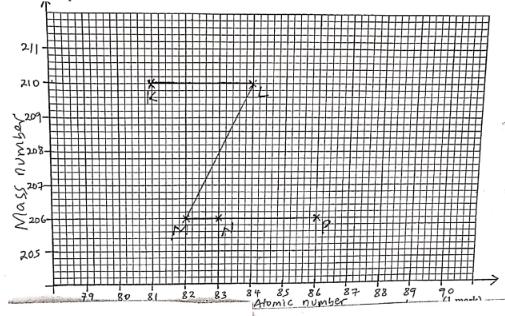
-
- Define the term decay series (1 mark)
- Write a nuclear reaction for the reaction that occurs when L changes to M. (1 mark)
- Identify a pair of isotopes of an element in the decay series. (1 mark)
- The table below shows the amount of radioisotope polonium
remaining after decaying to
Amount of PO-210 remaining in gram 400 300 200 100 40 20 Time in seconds 0.0 3.8 10.0 20.0 30.0 40.0 - On the grid provided, plot a graph of the amount of Po-210 remaining against time. (3 marks)
- Use the graph plotted to determine:
- The half life of polonium-210 (1 mark)
- The amount of polonium-210 remaining after 80 days. (1 mark)
- Write a nuclear equation to show the decay of polonium-210. (1 mark)
- Give one application of radioisotope in industry. (1 mark)
-
-
- In an experiment to determine enthalpy change between 2g solid A and Hydrochloric acid the following procedure was done:
- 30cm3 of 2M Hydrochloric acid was placed in a plastic beaker.
- Initial temperature of acid was measured and recorded as shown in the table 1 below.
- All the solid A was added to the acid at once, the mixture was stirred with a thermometre and temperature of the mixture was measured after every half minute and recorded as shown in table I below.
table I
Time (minutes) 0 ½ 1 1½ 2 2½ 3 3½ 4 Temperature (°C) 23.0 21.0 20.0 18.0 17.0 17.0 19.0 21.0 22.0 - On the grid provided plot a graph of temperature against time. (3 marks)
- From the graph determine:
- Change in temperature ΔT in °C
- Time taken from reaction to occur
- Determine:
- Enthalpy change for reaction given that: C=4.2J/g/k, Density of solution = 1g/cm3 (2 marks)
- Enthalpy reaction involving 1 mole of solid A and Hydrochloric acid (Formula of solid A = 382)
- Study the equations below representing enthalpy of Neutralization (M and N are not actual symbols) of MOH, NOH, and HCI
MOH(aq) + HCl(aq) → MCl(aq) + H2O(l) ΔH = −57.3kj/mol
NOH(aq) + HCl(aq) → NCl(aq) + H2O(l) ΔH = −51.4kj/mol- Which of the bases is a weak (1 mark)
- Explain your answer in (i) above (1 mark)
- In an experiment to determine enthalpy change between 2g solid A and Hydrochloric acid the following procedure was done:
- The set-up shows gas X undergoing combustion and forms a product which gives a white precipitate with lime water.
- State one error in the set-up (1 mark)
- State the identity of gas X (1 mark)
- State the colour of the flame Y (1 mark)
- Write a balanced chemical equation for the reaction between product of burning gas x and lime water. (1 mark)
- State the purpose of the aspirator. (1 mark)
- State and explain what is observed when excess of product formed is bubbled through the white precipitate (2 marks)
- State the purpose of gas X in the extraction of iron form its ores (1 mark)
- Draw the dots (.) and cross (x) diagram for gas x. (1 mark)
-
- Oxygen is obtained on large scale by Fractional distillation of air as shown on the scheme diagram below.
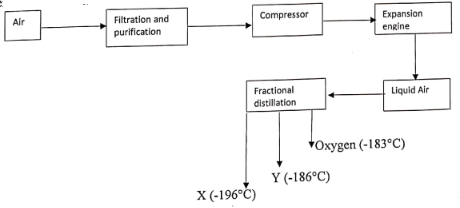
- Identify the substance that is removed at the filtration stage. (1 mark)
- Explain why Carbon (IV) Oxide and water are removed before liqufication of air. (1 mark)
- Identify the component that is collected at -186°c (1 mark)
- State one industrial use of gas X (1 mark)
- In an experiment, a piece of Magnesium ribbon was cleaned with steel wool. 2.4g of the clean Magnesium ribbon was placed in a crucible and completely burnt in oxygen. After cooling the product weighed 4.0g
- Explain why it was necessary to clean magnesium ribbon. (1 mark)
- What observation was made in the crucible after burning magnesium ribbon? (1 mark)
- Why was there an increase in mass? (1 mark)
- Write a chemical equation for the major reaction which took place in the crucible? (1 mark
- The product in the crucible was shaken with water and filtered. State and explain the observation which was made when red and blue litmus paper were dropped into the filtrate. (2 marks)
- Oxygen is obtained on large scale by Fractional distillation of air as shown on the scheme diagram below.
- Study the flow chart below and answer the questions that follow.
-
- What observation will be made in step I (1 mark)
- Describe a chemical test that can be carried out to show the identity of compound C. (2 marks)
- Give the names of the following;
- E (1⁄2 mark)
- Substance D (1⁄2 mark)
- Give the formula of substance B (1 mark)
- Name the process that occurs in; (2 marks)
- Step II.....
- Step IV..
- Give the reagent and condition necessary for step VI (2 marks)
- The relative molecular mass of E is 16,800. Calculate the number of monomers that
-
- Study the flow chart below and use it to answer the questions that follow;
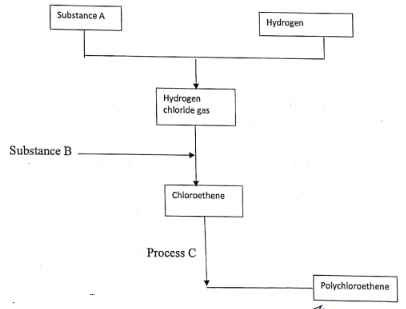
- Identify substance
- A ((1⁄2 mark)
- B (1⁄2 mark)
- Name process C (1 mark)
- Write an equation for the reaction in which hydrogen chloride gas is produced. (1 mark)
- State and explain the observation that would be made if chlorine gas was bubbled into an aqueous solution of sodium bromide.
(2 marks) - In the preparation of Sodium hypochlorite, a bleaching agent, excess Chlorine gas was bubbled into 10 litres of cold IM Sodium hydroxide solution.
- Write an equation for the reaction that took place between Chlorine gas and cold dilute IM Sodium hydroxide solution. (1 mark)
- Calculate the number of moles of Sodium hydroxide used. (2 marks)
- Mass in Kilograms of Sodium hypochlorite produced. (2 marks)
- Identify substance
-
- Aqueous Ammonia solution is passed through a colourless solution X, a white precipitate which dissolved in excess ammonia to form a colourless solution is formed.
- Identify the cation present. (1 mark)
- Explain the formation of a colourless solution. (1 mark)
- Write the formula of the substance formed in (ii) above. (1 mark)
- Study the flow chart below and answer questions that follow.
- Name catalysts (2 marks)
- X
- Z
- Give one source of Nitrogen gas (1 mark)
- Name the following substances. (2 marks)
- Gas S
- Salt Q
- Name another condition necessary for the reaction in step 1 to occur other than the
- State one laboratory use of salt Q
- Name catalysts (2 marks)
- Aqueous Ammonia solution is passed through a colourless solution X, a white precipitate which dissolved in excess ammonia to form a colourless solution is formed.
MARKING SCHEME
- The table below shows data on the elements K to R. Study it and answer questions that follow. The letters used do not represent the actual symbol of the elements..
Element Atomic number Melting point (°C) Ionic radius (nm) K 11 98 0.095 L 12 650 0.065 M 13 660 0.050 N 14 1410 0.041 O 15 44.2 and 590 0.34 and 0.212 P 16 113 and 119 0.184 Q 17 − 101 0.181 R 18 − 189 - 2.8.3
-
- Giant atomic structure with strong covalent bonds throughout the structure.
- exhibits allotropy.
- Q and R.
- stable electron configuration
-
- L(s) + 2H2O(l) → L(OH)2(aq) + H2(aq)
- MCl3(s) + 3H2O(l) → M (OH)3(s) + 3HC|(aq) ✓ 1
-
-
- Molten Na is used as reducing agent in manufacture of Titanium
- NaCl is used as food additive.
- Sodium vapour gives yellow glow in streetlights
- Alloy of Na and K is coolant in nuclear reactor
- State the nature of the oxide of element:
- Q - acidic
- M - amphoteric
-
-
-
- Sequential and continuous dishtegration of unstable nuclide to stable nuclide.
-
- M, N and P
-
-
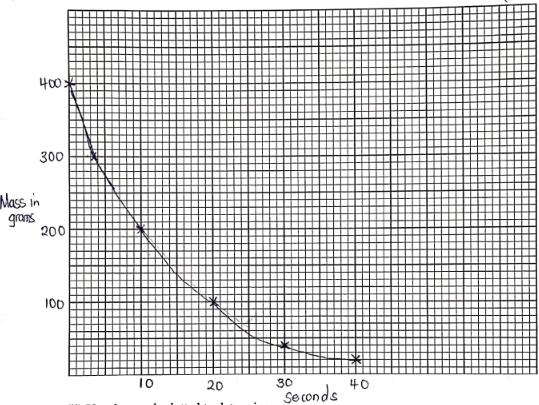
-
- 10 Sec
-
-
-
- Gauging thickness of thin and paper shoots.
- Measure levels of food in canned / packed containers.
- Make nuclear weapons
-
-
-
-
-
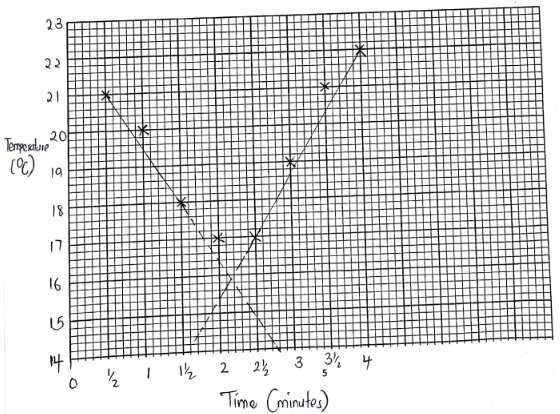
-
- Change in temperature AT in °C
- 23- Correct lowest temp from graph = ΔT°C
- Time taken from reaction to occur
- correct time on extrapdation.
- Change in temperature AT in °C
-
- ΔH = mcθ
= 30 × 4.2 × correct ans b(i) = Ans J or KJ - 2g → correct ans in c(i)
382g → ?
Correct ans KJ/mole
- ΔH = mcθ
-
-
- NOH
- Weak base dissociates partially some of heat is used to complete the dissociation before reaction goes to completion
-
-
- Delivery tube for gas outlet is dipping in the lime water.
- CO
- blue
- CO2(g) + Ca(OH)2(aq) → CaCO3(s) + H2O(l)
- To create sunction force for sucking the products at the flame.
-
- White ppt dissolver to form a colarless solution.
- CaCO3 reacts with CO2 in presence of water to form Ca(HCO3)2
- reduces Iron (lll) Oxide to lron
-
-
-
- Dust particles.
- They solidify at lower temperature blocking the pipes.
- Argon
- Manufacture of NH3(g).
-
- To remove layer of MgO on surface of Mg I
- White powder is formed.
- Mg combines with oxygen to form MgO.
- Mg(s) + O2(g) → 2MgO(s)
- Moist red Litmus remains red and moist blue turns red. NH3 is basic.
-
-
-
- purple colour of H+ / KMnO4 decolourizes
- Add. NaHCO3/Na2CO3 to C, efferevesence is produced
-
- E - polyethene
- Subtance D - sodium ethoxide
- C2H4Br2 OR

-
- Step II - Dehydration
- Step IV - Hydrogenation
-
- Reagent methanoic acid.
- Condition - Warm/concentrated H2SO4
-
n = 16,800 = 600
(12×2) + 4
-
-
-
- A - Cl2
- B - ethyne/ C2H2
- addition polymerization...
- NaCl(s) + H2SO4(l) → NaHSO4(aq) + HCl(g)
- Brown solution is formed Cl2 displaces Br− from Sodium bromide solution..
-
- 2NaOH(aq) + Cl2(g) → NaCl(aq) + NaOCl(aq) + H2O(l)
- 1 mole → 1000
? → 10,000
= 10 moles - NaOH : NaOCI
2 : 1
10 : 5 moles
mass = 5 x (23 +16 +35·5)
= 372.5 = 0.3725kg
1000
-
-
-
- Zn2+
- White precipitate of Zn(OH) reacts with excess NH3(aq) to form colourless solution of tetraamine Zinc (II) ion
- [Zn(NH3)4]2+
-
-
- X - Finely divided. Iron catalyst
- Z - platinum rhodium
- fractional distillation of liquid air
-
- Gas S... Nitrogen (IV) oxide
- Salt Q... Ammonium nitrate.
- Name another condition necessary for the reaction in step 1 to occur other than the catalyst.
- Temperature (400-500)°C
- Pressure (200-500)atm
- Mixture of N2: H2 in the ratio 1:3
- To prepare Nitrogen (I) Oxide
-
-
Join our whatsapp group for latest updates
Tap Here to Download for 50/-
Get on WhatsApp for 50/-
Download Chemistry Paper 2 Questions and Answers- Mokasa 1 Joint Pre Mock Exams 2023.
Tap Here to Download for 50/-
Get on WhatsApp for 50/-
Why download?
- ✔ To read offline at any time.
- ✔ To Print at your convenience
- ✔ Share Easily with Friends / Students


